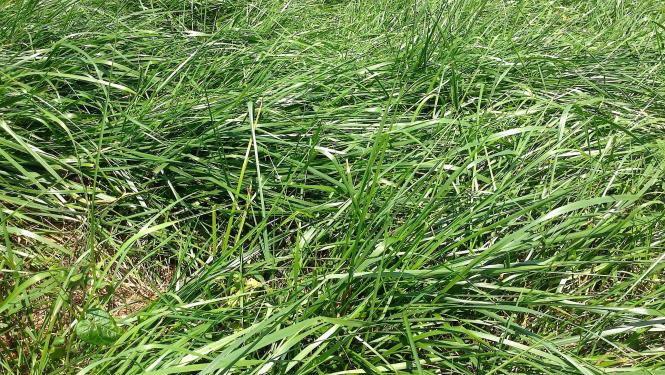Tall Fescue is popular as a cultivated pasture grass because of its relative ease of establishment, drought and grazing tolerance, and long grazing season compared with other cool season grasses. Research has shown that many of these traits that make fescue so popular are due to the presence of a fungus (Neotyphodium coenophialum) that lives inside the plant (endophyte). The fungus is transmitted in the seed. Toxins typical in endophyte infected (E+) fescue have been shown to cause fescue toxicosis which reduces cattle growth, reproductive performance and health. This reduction in cattle performance results in an excess of $1 billion in lost income annually in the US. Novel endophyte (NE+) fescue varieties appear to have the survival advantages of the E+ varieties, but with none of the animal toxicity effects. For more information, see the fact sheet USDA-NRCS, The Economics of Replacing Endophyte Infected Fescue with Novel Endophyte Fescue on Cow-Calf and Beef Stocker Operations.
Recent analysis has shown a concentrated presence of the endophyte not only in the seed head, but in the base of the stem also. This fact explains the ability of infected varieties to resist overgrazing.
Testing for the Endophyte
In many cases, the effects of the endophyte may not be noticed until a non-infected product is grazed and the animal performance increases. However, to start the procedure to determine the endophyte contents of your pasture, testing is available. This testing can give you a clear direction of the amount and prevalence of the endophyte in your pasture. Below is a protocol example for testing your pastures. Most state labs offer this service and we encourage you to work with your local county agent to determine the procedure for your state.
Summary of Recommendations for Field Samples
Identify the area you are testing. Usually you will be sampling an individual field, but sometimes parts of a field where there are obvious differences in, for example, soil type, drainage, or slope or the age or appearance of stands, or part of a farm could be sampled. For seed, ensure the sample is representative of the seed lot being tested.
Plan a route that covers the sampling area uniformly. Sample long (i.e., ungrazed) and short (i.e., heavily grazed) areas equally. Avoid bias for or against these areas since they may have different endophyte levels Both “line” and “random” sampling give similar results.
Sample in summer or fall. Avoid sampling in spring and winter because that may result in inconsistent results.
Collect 20 to 50 tillers of tall fescue from different plants.
Tillers can be pulled by hand or cut, but samples should be taken low enough that some remnant roots are present. The ideal plant portion for testing is the pseudostem, 1 inch above the junction between roots and shoots.
Avoid selecting extra-large or extra-small tillers; select tillers that are of average size for the field.
Sample only vegetative tillers, avoiding plants in the boot stage with emerging heads or with mature seedheads.
Avoid plants with soil or fecal contamination.
Ensure that any plant (i.e., clump, bunch) is sampled only once.
Remove surplus leaves and dead material, and put the tillers into a sealable plastic bag. To prevent any confusion, label the bag immediately, including your name, field identification, and date of sampling. Once labeled, place the bag in a cooler with ice.
If an ice pack is available, pack the tillers with it and send by overnight courier to the testing laboratory. (forages.oregonstate.edu)
